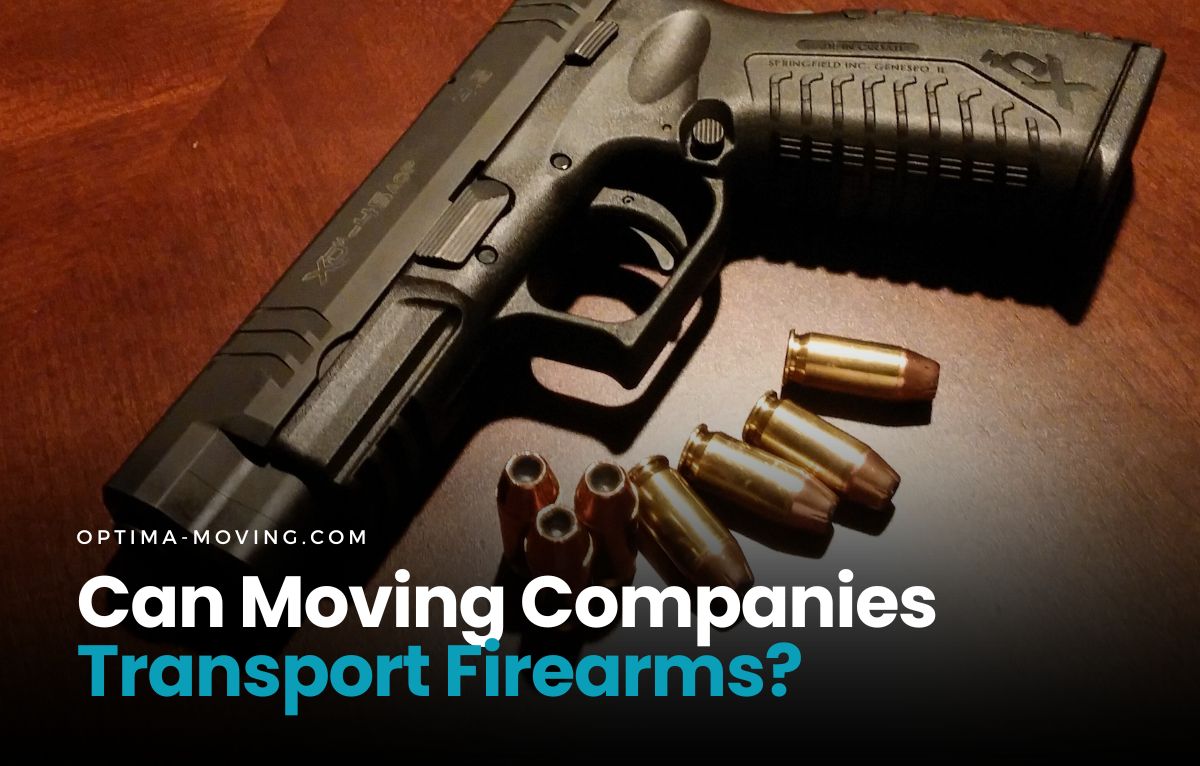Moving day already has a lot of moving parts, and firearms add a layer of rules you cannot ignore.
If you own guns and are planning a relocation, the first question that often comes up is simple: can moving companies transport firearms?
The answer depends on your mover’s internal policy, your starting and destination states, and how you prepare your firearms before the truck arrives.
With a little planning, clear communication, and careful packing, you can keep your move smooth and stay on the right side of the law.
Why It Varies
The short answer to whether moving companies can transport firearms is this: some will, some will not. Even when the law allows you to possess and transport firearms, many carriers set their own rules to reduce risk.
A national van line may permit locked, unloaded firearms inside their inventory under strict conditions, while a local mover might decline entirely.
That difference usually comes down to insurance coverage, staff training, and the company’s tolerance for liability.
You avoid confusion by asking early, getting the policy in writing, and following every instruction they provide.
Federal Basics and State Differences
Federal law offers a general structure, but states add their own details. If you are crossing state lines, transport is usually permitted when the firearms are unloaded and locked in a case that is not easily accessible, with ammunition stored separately.
Some states require new resident registrations after you arrive, some restrict magazine capacity, and others classify certain models in ways that change the rules.
Because regulations are not uniform, you should map your route and check your origin, destination, and any overnight stop laws before you pack.
If you plan to fly part of the journey, the airline and TSA have separate rules for checked baggage that you must follow, which include declaring the firearm at the ticket counter and using a hard‑sided, lockable case.
What Movers Allow and How to Ask
Safe preparation starts before the boxes come out. Confirm every firearm is unloaded, and check the chamber visually and physically.
Place each firearm in a hard‑sided, lockable case, then add a cable or chamber flag if you have one to show it is safe.
Keep ammo in its original packaging, inside a separate container, and store that container apart from the firearms during transport.
If the mover allows firearms on the truck, keep the keys or combinations with you and never hand them to the crew.
Label cases in a way that makes sense during the move without announcing the contents to strangers.
For example, use “sporting equipment” or an internal code that you will remember.
If you own a gun safe, secure it and remove small interior parts that could shift during transit, then tell the mover the safe’s empty weight so they can plan for equipment and stair work.
Practical Alternatives
If your preferred company declines, you still have workable options. The most direct approach is to transport your firearms yourself in your personal vehicle.
Plan your route so you do not have to access the firearms during transit, and make hotel reservations in areas with secure parking and good lighting.
Another option is to work with a licensed firearms dealer who can ship from dealer to dealer, so you pick up your property after you arrive and complete any required transfer steps for the destination state.
A third path is to use a specialty carrier that focuses on high‑value, sensitive items.
These services cost more than standard freight, yet they offer tracking, dedicated handling, and extra insurance that may be worth it for rare or sentimental pieces.
Common Mistakes That Complicate a Move
Several missteps tend to cause stress on moving day, and they are easy to avoid with a little forethought. The first is waiting until the truck is at the curb to ask about firearms.
By that point, the dispatcher and driver are bound by policy and cannot make exceptions without risking their job or voiding insurance.
The second is sloppy preparation, such as leaving a magazine inserted or packing ammunition in the same case as the firearm.
The third is poor labeling that attracts attention in public spaces. Finally, some owners forget to prepare documentation.
Keep photos, purchase records, and a private inventory with serial numbers so you can prove ownership if you ever need to file a claim or police report.
Planning Your Move Step by Step
Start with research, then create a simple checklist. Confirm your mover’s policy in writing, review basic transport laws for your route, and decide who physically moves the firearms.
Prepare your cases and ammunition storage at least a week in advance so you are not juggling parts on loading day.
Set aside keys and combinations in a separate pouch you keep on your person.
If you are driving your firearms, lock the cases and place them in an area of the vehicle you cannot access while seated, then map fuel and hotel stops to limit exposure.
When you arrive, move the cases directly into a secure room before you unpack other items, and perform a quick inspection to confirm every item is present and undamaged.
Bottom Line
By now you should have a clear plan and a safe answer to whether moving companies can transport firearms.
The right path comes from three inputs: the law for your route, the mover’s written policy, and your preparation.
If your mover accepts firearms under defined conditions, follow those steps precisely. If not, use personal transport, a licensed dealer transfer, or a specialty carrier.
For moves in and around Maryland, the team at Optima Moving can help coordinate the rest of your household, explain what their crews can and cannot carry, and schedule packing, loading, and delivery so you move with confidence and clear expectations.




